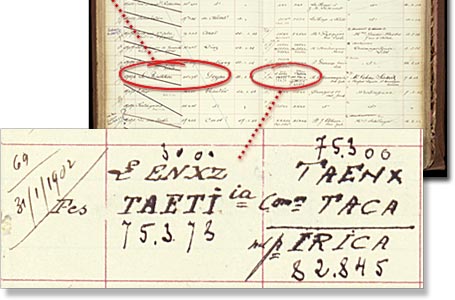Stock Books
Art dealers, like most merchants, maintain detailed ledgers or stock books to keep track of works bought, sold, or consigned. These books usually include entries with details about the work of art and the transaction. Such entries provide invaluable primary evidence for the study of the art market and can assist in establishing and authenticating the provenance of works of art.
Dealer Codes
Dealers prefer to keep their profits secret. Most employ cryptographic codes to record buying and selling prices. These codes typically use a key consisting of one word of 9 non-repeating letters. Each letter corresponds to a number. The key code word for this stock book is "PRECAUTION." Therefore P=1, R=2, E=3, C=4, A=5, U=6, T=7, I=8, O=9, and N=0 (X and Z also represent zero). In entry 27473 , Boussod, Valadon paid 75,378 (TAETI) francs for Edgar Degas' La Répétition and sold it for 82,845 (IRICA) francs. A later owner of the stock book added the numbers inscribed above the letters.
Some dealers also used codes names to refer to their clients in correspondence. Dealer Joseph Duveen's code names indicated a sense of humor. For example,
competing dealer Knoedler and Company was identified as "KNIFE," while the collector and newspaper publisher William Randolph Hearst, who was associated with yellow journalism, was known as "HASTY."
|
 |
 Boussod, Valadon & Co. stock book (details),
Boussod, Valadon & Co. stock book (details),
about 1900
The purchase and sale price are listed in code. |

